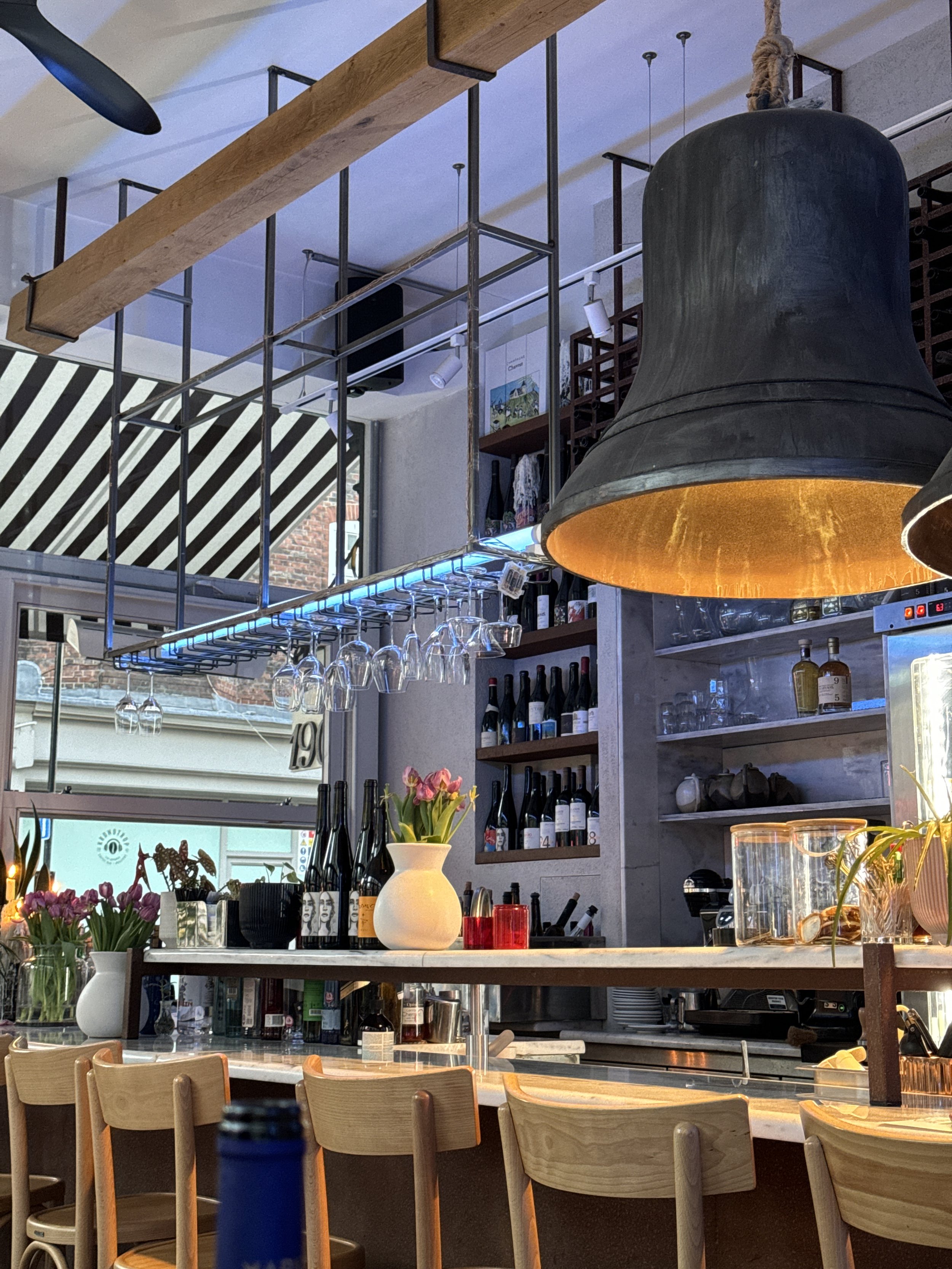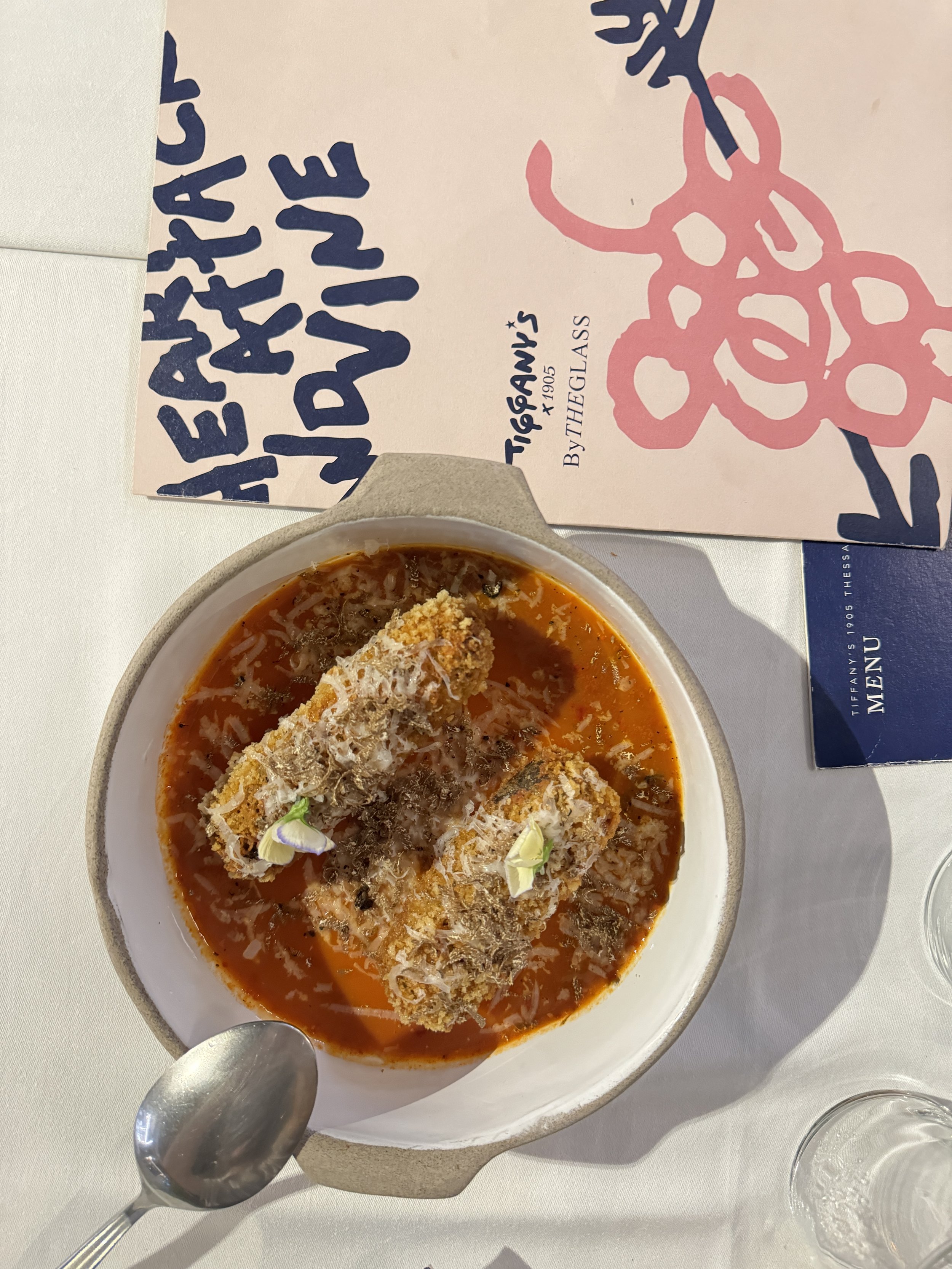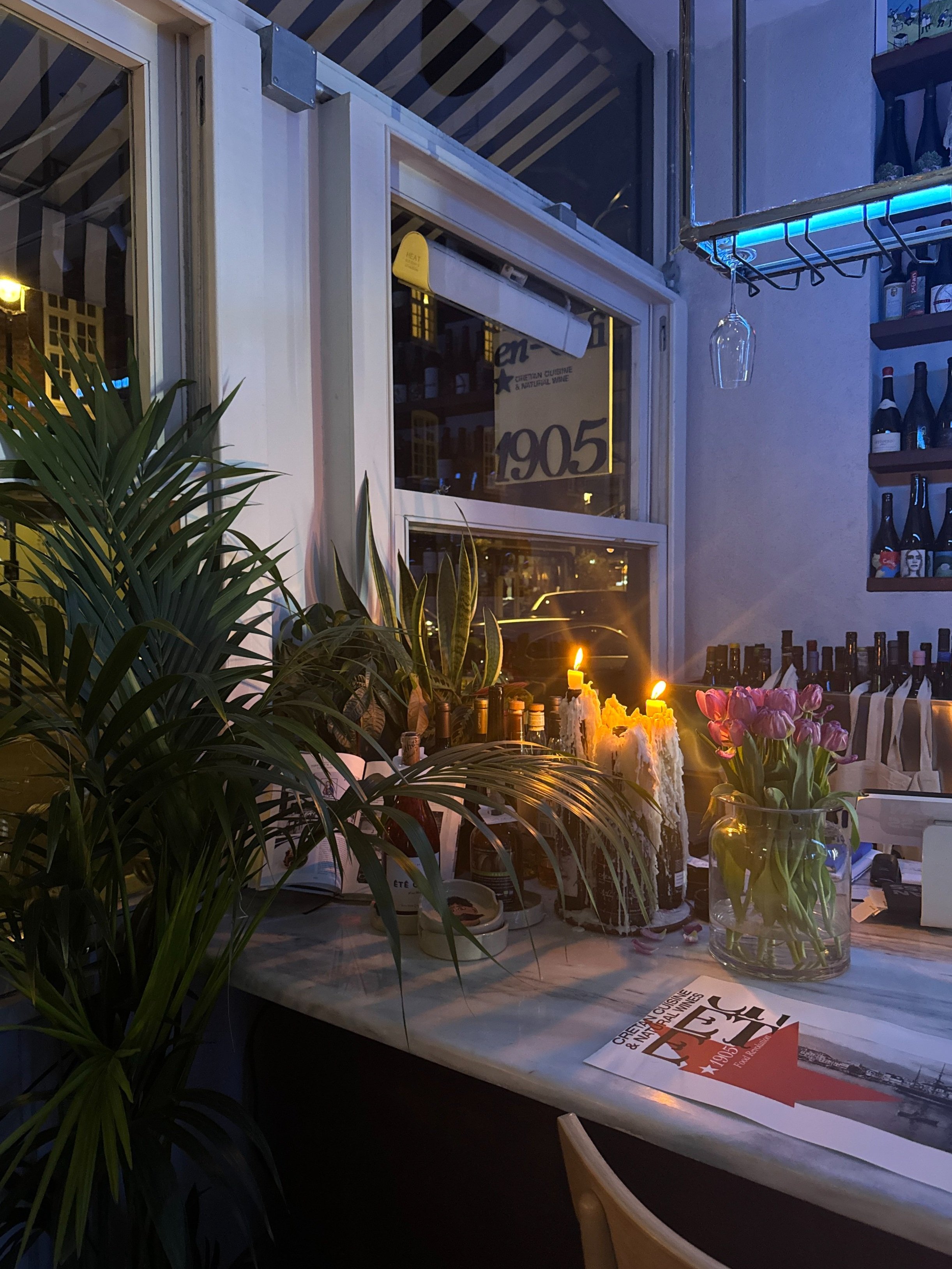Cretan Revolution in central London: The Greek restaurant where you’ll find gamopilafo and lichnarakia
A contemporary, stylish but honest ode to Cretan cuisine – 1905 being the year of the Cretan revolution. How can a restaurant be traditional, authentic, creative and modern at once?
If London lacks the spirit of the Mediterranean, then this unsung Greek spot in Fitzrovia is somewhat of an oasis. At a crossroads just a short walk from Regent Street is a bright corner that always seems to catch the sun. The more you look, the more you realise it sort of seems… out of place. Not because of the outside tables and chairs facing the street, nor because of the casually-cross-legged diners swirling and swigging glasses of natural wine on a dry day. Something here feels different. It all feels, dare I say it… very Mediterranean. It might look sleek and modern, but make no mistake: Nineteen-0-Five (or 1905) is the place that has managed to capture the essence of Greece in a way that is current, stylish and real on this unlikely corner of an otherwise grey Mortimer Street.
Pulling that off takes more than good food and an authentic menu, but let’s start there. The giveaways of genuine authenticity are takes on gamopilafo - Cretan ‘wedding rice’ - Cretan pasta dishes (makarounes and skioufikta), sweet, soft and crumbly lichnarakia pies for dessert, and of course the famous Cretan dakos in salad form. For the meraklides, a snail dish, or boubouristoi, as Cretans commonly call them due to the fact that they place them in the pan ‘face down’. Add Cretan apaki, Peloponnesian siglino (also known as pasto), kakavia (fish soup) and koliva (a wheat and berry mixture served at memorials), and there’s no question whatsoever as to whether this is a bona fide Greek restaurant, or just another venture by restaurateurs tapping into an undersaturated niche.
Skioufikta.
Beef cheeks with hilopites pasta.
London’s only Cretan restaurant
To be clear, this is a convincing case of the former, and the menu is a large reason as to why. Where else are going to find antikristo and chestnut stifado on a menu in London? Firstly, these are dishes that are hard enough to find in Athens, let alone London. Although it’s a tall order to expect someone to make antikristo in the middle of central London the way you’d see it in Crete, this isn’t really a place that takes shortcuts: the kitchen makes the lichnarakia (or kalitsounia) in-house. Sweet, mini, flower-shaped mizithra cheese pies that herald the start of spring, popular around Easter. Secondly, the dishes, very frankly, taste nice. Don’t underestimate this point, and hear me out. People adore Greek cuisine so much because it’s a masterclass in making the daringly simple, affordable and accessible into something unbelievably delicious; dishes of a handful of ingredients that make you think, ‘wow’ and ‘how?’. Yet, it’s not often that you see Greek restaurants live up to that ethos in London at an understandable price point.
Lichnarakia are hard enough to track down in Greece’s capital, let alone London. 1905 makes them from scratch, having previously sourced them from a bakery in Chania.
1905 vs other Greek restaurants in central London
Most of central London’s Greek restaurants adhere to a paradigm of – on the one end – strategically-priced, high-end spots in prime-real-estate locations that target the Mykonos-frequenting class of ‘Philhellenes’ and – on the other – a sprawling Japanese conglomerate-owned chain that the vast majority of Greeks in London can’t really connect with. In other words, you tend to either get ‘overpriced’, or ‘underwhelming’. The best of the rustic, traditional spots tend to require a trip to north London or Hertfordshire, with a couple others dotted around west and south London.
To be able to find the middle-ground in the heart of Fitzrovia, with a distinct but no-nonsense menu that showcases good ingredients and good Greek cooking, is incredibly noteworthy. The restaurant’s location, combined with the fact that it delivers, is a double-win that quickly earned the praise of respectable British critic Giles Coren (who is notoriously hard to please) back in 2023, just a few months after it first opened. He too called 1905, among other good things, ‘honest’.
Salad served out of a plant pot?
There aren’t any gimmicks, but beautiful sparks of creativity that work. For the sake of complete transparency: I initially rolled my eyes at the idea of a salad served out of a plant pot. It’s the kind of theatric you might fear a restaurant is using to push an otherwise underwhelming dish. Here, the ‘Cretan pot’ is a delicious salad comprising (among other things) fresh cherry tomatoes bursting with flavour, artichokes, Cretan staka butter cream, potatoes and orange. Once you try it, you understand that serving the paximadia (rusks) in ‘soil’ form is more than a visual embellishment, but actually ties everything together. Emptying the pot upside down reveals a vinaigrette that trickles onto everything and evenly coats it, with the soil now at the bottom ready to catch it. It makes you reconsider the conventional approach to salad-eating, which normally entails scooping away at lonely puddles of salad dressing, paximadia shattering across the table as you try to fork them, and the awkward conversational disruption that is digesting a whole paximadi. My meals rarely begin with wolfing down a salad starter like it’s the main, but this one did.
The gamopilafo is ‘deconstructed’.
The restaurant doesn’t alter or rewrite Cretan classics, it just serves them in a way that is fresh, trendy, and actually works in surprising ways. The gamopilafo is served ‘deconstructed’. Even before it all comes together, it works: you get the ritual of mixing it all together yourself, and it prompts you to appreciate the components individually. The meat is a mixture of braised lamb and chicken that tastes like Greece, i.e. perfectly cooked, simple but perfectly seasoned, with optimal quantities of broth, oil and lemon. I repeat: it tastes like Greece, and I have rarely ever thought that in London.
It’s hard to think of many other Greek spots that manage to simultaneously tick so many boxes – authentic but contemporary, traditional but modern, informed but creative. Without the contradictions nor hypocrisy. Here you find great quality and flavour without the extortionate pricing. It’s refined yet filling and fulfilling. A killer wine list doesn’t rule out a round of the traditional spirits (raki/tsikoudia and rakomelo), and the front-of-house staff don’t give you funny looks for ordering ouzo the way all Greeks typically drink it (as happened at one notable opening in Borough).
Let’s be honest, London is expensive. Ergo, to survive, all restaurants have to price their product accordingly. The point here is that this spot doesn’t push its luck beyond that; you don’t leave feeling cheated or lied to. It’s no secret, on the other hand, that there are now a few refined, high-end Greek spots in central London that exploit their position in the market by charging way over the odds, with value-based pricing (a strategy based on perceived value which luxury brands use) that has no regard whatsoever for value-for-money and has no relation to cost at all.
Such spots enjoy excessively comfortable margins on some dishes. Opso and Gaia spring to mind, the latter of which distinguished critic Jay Rayner called ‘nosebleedingly expensive’ in 2024. If you’re one of the majority to whom money does mean something, then it’s those spots that tend to leave you feeling disappointed. 1905 could easily be one of those restaurants that leverage their almost-uncontested position in their neighbourhood and niche by hiking their margins. They choose not to. While, at aforementioned Gaia, a portion of vegetarian gemista – vegetables stuffed with rice – will cost you £32, you won’t find a single dish at 1905 that costs as much.
Good wine, good company
It’s not so easy to see who’s running the overpriced spots either, with pretentious atmospheres working as decoys to veil the void. In contrast, you tend to find the same faces and the same warm, natural welcome when you arrive at 1905. Nikos Nyfoudis and Kostas Moustakidis are the kind of owners who you can actually find at their restaurant, hence it’s no surprise that the rest of the team amplify that welcome. Giorgos, himself a Cretan with a track-record in London’s Greek food scene, is the front-of-house charisma that manages to effortlessly squeeze a smile and chuckle out of almost every interaction (even before he brings your raki and rakomelo). Likewise, Klontia is the bright and lively personality behind the restaurant’s upbeat and effervescent social presence. As good as the food might be, it’s always personal impressions and interactions that keep you returning to your favourite spots. Every time I have been to 1905, there always seems to be a bulging table of Greeks by the back wall who fill the room with hearty laughter and a gentle buzz. They always seem to feel at home, and the feeling is infectious. It’s those small impressions that determine the trajectory of your dining experience and your memories of it.
A pertinent point because that, to a large degree, is something that irrefutably contributes to the essence of Greek cuisine and the atmosphere within which you inevitably encounter it. We don’t need to overstate the unanimously positive feeling that people throughout the world feel towards Greek hospitality thanks to its personable nature. Here, that personable approach is manifest on the menu and the interior. A passion for wine isn’t hidden – Nikos Nyfoudis declares it on the menu himself and commits his signature beneath it. A wine-first philosophy doesn’t mean the food is an afterthought; rather, it means that you enjoy a consciously-curated, affordable wine list in central London, with a fair focus on smaller, organic, natural wineries from around the world, and an enthusiasm is reflective of Greece’s flourishing wine scene.
The love for wine is clear, and not only from a wine list that features respectable and award-winning names in the Greek wine sphere like Thymiopoulos, Mylonas and Sclavos. As I’m writing, Nikos Nyfoudis is in Greece posting about wines on his Instagram stories, and advising which dishes pair best with two of his current favourites. Nothing unusual. There, 1905’s sister restaurant is another one of his conceptions. Tiffany’s is the reincarnation of the fabled Thessaloniki bistrot that raised generations, this time with the same wine infatuation that you see at 1905.
Tiffany’s x 1905 in Thessaloniki.
1905 in London.
Back in London, Nikos already made his mark on the Greek food scene and won the hearts of London’s Greek community with the chic, understated gem that is The Life Goddess (Store Street and Kingly Court). Many Greeks who study and work in London consider it to be one of London's few authentic Greek spots, perhaps also partly due to the series of successful events it held before the pandemic.
In a big city of haste and fleeting moments, places like 1905 are the change of pace, proving that, in fact, Greeks can stay current without ditching the traditions of the world’s favourite cuisine, and without eschewing its ethos of accessibility, simplicity and personability. Authenticity isn’t in the number of Greek words that appear on a menu; rather, in the dishes themselves and the atmosphere in which you experience them. It’s about a true love and understanding of food and wine, plus the people who are there to enjoy it. 1905 sometimes holds intimate live music nights, even if there may not be much financial incentive in running them. Just as the motto at Tiffany’s is “come as you are”, this too is a restaurant by and for people who do things with meraki. Real, honest, fair – without that being an excuse to cut corners. It’s personable, intimate, and increasingly cosy when afternoon begins to blur into evening.
As the sunset cascades westwards beyond Great Portland Street and the headquarters of the BBC, the restaurant begins to glimmer and glow with candles that wrap themselves around well-loved wine bottles – fitting. Plants sway back and forth in a corner as a gentle breeze sneaks in through the front door, casting a stripey wave of soft shadows across the restaurant that mirror the navy-white awnings outside. The glint of a flickering candle flirting with another bottle refracts into the corner of your eye, and the subtle buzz mellows into a charming murmur, as conversations mature with the help of some wine (and raki).
It’s naturally intimate, it’s romantic, it’s real. It’s the perfect spot for a date or casual catch-up with family or friends. And, for London, it’s revolutionary.
* This is neither a paid-feature article nor an advertisement or promotion. All views are those of the author and all photos are copyright protected and not permitted for reuse without explicit prior permission.












